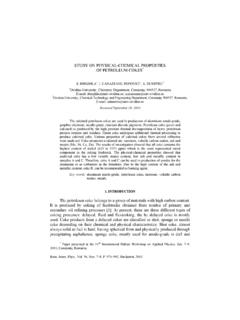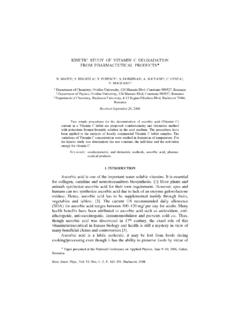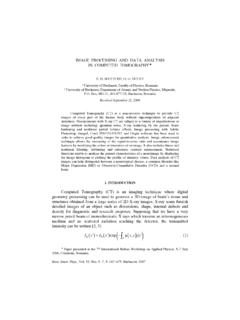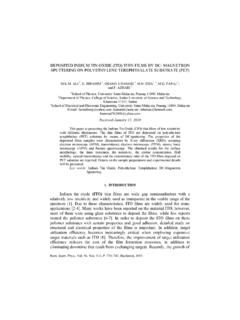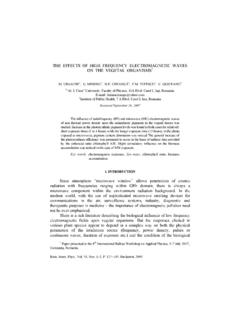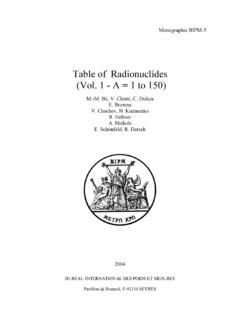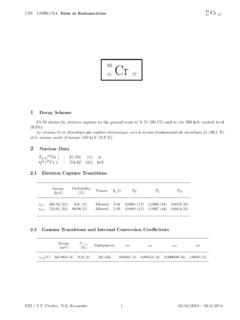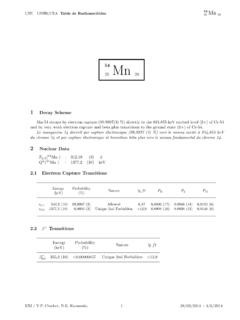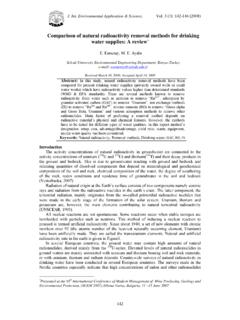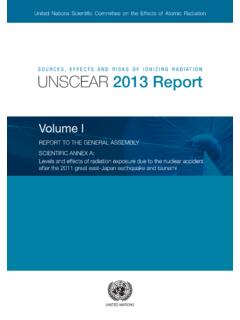Transcription of ASSESSMENT OF NATURAL RADIOACTIVITY LEVELS AND …
1 ENVIRONMENTAL PHYSICS ASSESSMENT OF NATURAL RADIOACTIVITY LEVELS AND radiation HAZARDS FOR BUILDING MATERIALS USED IN QASSIM AREA, SAUDI ARABIA A. EL-TAHER1,2 1 Physics Department, Faculty of Science, Qassim University, Buraydah, 51452, Saudi Arabia 2 Physics Department, Faculty of Science, Al-Azher University, Assuit Branch, 71542 Assuit, Egypt E-mail: Received July 3, 2011 Building materials are one of the potential sources of indoor RADIOACTIVITY because of the naturally occuring radionuclides in them. External as well as internal exposures are the two pathways of radiation dose imparted to the human beings from the building materials. NATURAL RADIOACTIVITY LEVELS of 35 samples of NATURAL and manufactured building materials used in Qassim area, Saudi Arabia have been investigated by using gamma spectrometer with NaI(Tl) detector. The samples were collected from local market and construction sites.
2 From the measured -ray spectra, activity concentrations were determined. The activity ranged from to Bq kg-1 for 226Ra, from to Bq kg-1 for 232Th and from 64 3 to 340 Bq kg-1 40K. The activities are compared with available reported data from other countries and with the world average value for soils. The radium equivalent activity Raeq, the external hazard index Hex and the absorbed dose rate in air D in each sample was evaluated to assess the radiation hazard for people living in dwelling made of materials studied. All building materials have shwon Raeq ranged from to kg-1. These values are lower than the limit of 370 Bq kg-1 adopted by OECD the Organization for Economic Cooperation and Development. The absorbed dose rate in indoor air are lower than the international recommended values of 55 n Gy h-1 for all test samples. All the materials examined are acceptable for use as building materials as defined by the OECD criterion.
3 Key words: NATURAL RADIOACTIVITY , building materials, radiation hazard parameters. INTRODUCTION All building raw materials and products derived from rock and soil contain various amounts of mainly NATURAL radionuclides of the uranium (238U) and thorium (232Th) series, and the radioactive isotope of potassium (40K). In the 238U series, the decay chain segment starting from radium (226Ra) is radiologically the most important and, therefore, reference is often made to 226Ra instead of 238U. These radionuclides are sources of the external and the internal radiation exposures in dwellings. The external exposure is caused by direct gamma radiation while the Rom. Journ. Phys., Vol. 57, Nos. 3 4, P. 726 735, Bucharest, 2012 2 ASSESSMENT of NATURAL RADIOACTIVITY LEVELS and radiation hazards for building materials 727 inhalation of radioactive inert gases radon (222Rn, a daughter product of 226Ra) and thoron (220Rn, a daughter product of 224Ra), and their short-lived secondary products lead to the internal exposure of the respiratory tract to alpha particles.
4 The specific activities of 226Ra, 232Th and 40K in the building raw materials and products mainly depend on geological and geographical conditions as well as geochemical characteristics of those materials [1]. The radiological impact from the NATURAL RADIOACTIVITY is due to radiation exposure of the body by gamma-rays and irradiation of lung tissues from inhalation of radon and its progeny. From the NATURAL risk point of view, it is necessary to know the dose limits of public exposure and to measure the NATURAL environmental radiation level provided by ground, air, water, foods, building interiors, etc., to estimate human exposure to NATURAL radiation sources [2]. Low level gamma-ray spectrometry is suitable for both qualitative and quantitative determinations of gamma-ray-emitting nuclides in the environment. The concentration of radio-elements in building materials and its components are important in assessing population exposures, as most individuals spend 80% of their time indoors.
5 The average indoor absorbed dose rate in air from terrestrial sources of RADIOACTIVITY is estimated to be 70 nGyh-1 [3]. Great attention has been paid to determining radionuclide concentrations in building materials in many countries [4-13]. In Saudi Arabia the information about the RADIOACTIVITY of building materials is limited therefore, it is important to study: 1) Assess NATURAL RADIOACTIVITY (226Ra, 232Th and 40K) in building materials used in Saudi Arabia by using -ray spectrometry, 2) Calculate the radiological parameters (radium equivalent activity Raeq, external hazard index Hex and absorbed dose rate) which is related to the external -dose rate to assess the radiological hazards to human health and for checking its quality in general and knowing its effect on the environment, 3) The measured activity concentrations for these NATURAL radio-nuclides were compared with the reported data for other countries.
6 The data obtained are essential for development of standards and guidelines concerning the use and management of building materials. SAMPLING AND SAMPLE PREPARATION A total of 35 samples of NATURAL and manufactured building materials used in Qassim area, Saudi Arabia have been collected from local market and construction sites. The sample each about 1 kg in weight were dried in an oven at about 105 C to ensure that moisture is completely removed. The samples were crushed, homogenized, and sieved through a 200 mesh, which is the optimum size enriched in heavy minerals. Weighted samples were placed in polyethylene beaker, of 350 cm3 volume each. The beakers were completely sealed for 4 weeks to reach secular equilibrium where the rate of decay of the daughters becomes equal to that of the parent [14-16]. This step is necessary to ensure that radon gas confined within the volume and the decay products will also remain in the sample.
7 A. El-Taher 3 728 INSTRUMENTATION AND CALIBRAT RADIOACTIVITY measurements were performed by gamma ray spectrometer, employing a scintillation detector 3"x 3". Its hermitically seald assembly which includes a high-resolution NaI (Tl) crystal, photomultiplier tube, an internal magnetic light shield, an aluminum housing and a 14 pin connector coupled to PC - MCA Canberra Accuspes. It has the following specifications: 1 Resolution specified at the 662 keV peak of 137Cs. 2 Window Alumminum thick, density 147 mg/cm2. 3 Reflector oxide; thick; density 88 mg/cm2. 4 Magnetic / light shield-conetic lined steel. 5 Operating voltage positive The efficiency calibration curve was made using different energy peaks covering the range up to 2000 keV. Measurements were performed with calibrated source samples, which contain a known activity of one or more gamma-ray emitters of the radionuclides 60Co ( and keV), 133Ba ( ), 137 Cs ( keV) and 226Ra ( keV).
8 With certified accuracies of < 2 % supplied by PTB Braunschweig, Germany. We used for calculating the absolute efficiency the eq.(1) BOCpATOCINEff = 100 (1) With: Np= net peak area (count/ S) at E , I = intensity of emitted -ray(%), TOC = time of counting (S), and ABOC = activity (Bq) of the standard source at beginning of counting (BOC). ABOC was calculated by eq. (2) ABOC = ADOC exp (- (BOC-DOC)) (2) Where ADOC is the activity (Bq) of the standard source at date of calibration DOC, and (s-1) is the decay constant. Daily efficiency and energy calibrations for each sample measurement were carried out to maintain the quality of the measurements. (BOC DOC) defined as elapsed time between initial calibration and moment of measurement. CALCULATION OF ACTIVITY Calculations of count rates for each detected photopeak and radiological concentrations (activity per mass unit or specific activity) of detected radionuclides depend on the establishment of secular equilibrium in the samples.
9 The 232Th concentration was determined from the average concentrations of 212Pb ( keV) and 228Ac ( keV) in the samples, and that of 226Ra was determined from the average concentrations of the 214Pb ( keV) and 214Bi ( and keV) decay products [17-21]. 4 ASSESSMENT of NATURAL RADIOACTIVITY LEVELS and radiation hazards for building materials 729 The activity concentration in Bqkg-1 (A) in the environmental samples was obtained as follows: meNA = p (3) Where Np = net count rate (cps), measured count rate minus background count rate, e is the abundance of the -line in a radionuclide, is the measured efficiency for each gamma-line observed for the same number of channels either for the sample or the calibration source, and m the mass of the sample in kilograms. RESULTS AND DISCUSSION Cement is an important construction material for houses and buildings in urban areas of Saudi Arabia.
10 It is used for blocks and concrete manufacturing as well as for plastering the buildings walls, which made of bricks. However, detailed information of the specific activities of 226Ra, 232Th and 40K in cement and other building materials used in Saudi Arabia is not available in literature. This study is a continuation of our ongoing project related to the measurement of specific activity of 238U (226Ra), 232Th and 40K in environmental samples from Saudi Arabia using gamma-ray spectrometric technique and estimation of the gamma dose rate from these radionuclides. The average of measured activity values together with their respective standared deviation (SD) of the above NATURAL radionuclides are presented in Table 1. As can be seen from Table 1, the activity concentrations of 226Ra, of sand, gravels, marble, limestone, gypsum and granite were lower than that of the world average for soil 35 Bq kg-1 [22].



